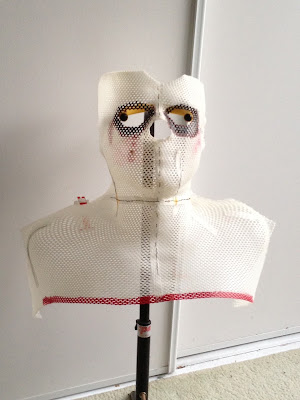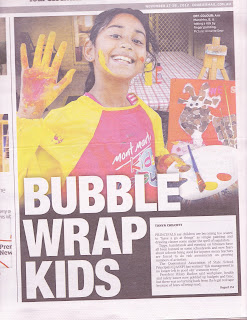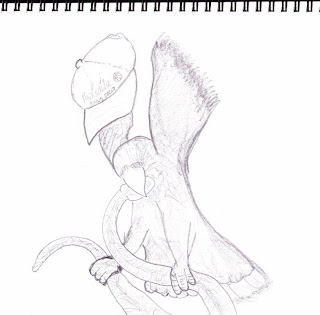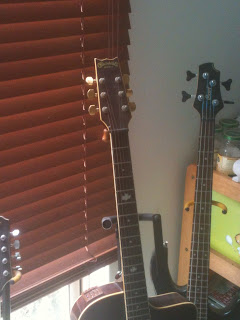Preface
The
following synopsis documents the influences by recognised artists and declarative
and procedural knowledge and skills acquisition processes of a pre-service teacher
in the development and creation of an original art work designed to portray the
issue of male mental health.
Synopsis
My
artistic appreciation and creative skills lay in music, photography and
audio-visual production prior to the commencement of this course. Before
engaging fully in the techniques and understandings of visual art, I became
engrossed in the creative
process of individuals whose work I have appreciated through my life.
Gaugin’s quote that “art is either plagiarism or revolution’ resounded in
musician Paul
Kelly’s demonstration to Andrew Denton of the evolution of a ‘signature’
piece of his work having evolved from a similarly arranged musical composition
by a band from the 1960s. Reflection on my existing tastes in art revealed a
preference for indigenous
Australian art and ‘street
art’ or at least art produced by people I either knew or could identify
with as ‘real’ people, whereby their work provided insights as to their
thinking and inspirations.
A common thread that emerged amongst my preferences was art that was either
derived from, or expressed, emotional calm or disquiet.
As
the course progressed my learning took the form of in-class experimentation
with materials and application techniques, reflection on and analysis of past
experiments as well as research and understanding of arts movements and the
artists who created and contributed to them. From the CQU intranet Moodle site
the Arts Movement Directory
provided a comprehensive listing of the existing, recognised art movements and
an accurate timeline of their evolution. This course resource provided an
enormous data bank of images and background information on the artists who
created the featured works. Some of the images are reproduced on my arts blog
site and I hereby acknowledge the resource and the moodle site as the sources
of the information and images.
Art
movements that captured my imagination were the surrealists and abstract
expressionists. Of the surrealists, Dali and Picasso were the most
interesting to me. Dali, whose
work of the thirties in line with the surrealist’s ideology, attempted to
describe the unconscious. The ‘dream
like’ distortions to surrealism and strong rich colours are the most
striking aspects of his work. Picasso
is the most intriguing and enigmatic of the early abstract expressionists. From
his ‘blue period’ from 1901 to 1904 where he expressed melancholy and pathos
through the use of restricted colour and simplified forms, Picasso was an
innovator of new styles such as hermetic and synthetic cubism and worked in
classical styles influenced by ballet. Around 1925 his figurative compositions
became grotesque and violently active with a tinge of the macabre exemplified
by his 1936
‘Guernica’ Biography Channel (2012). It was the artist’s own statement and
art critic’s analyses of the Guernica that initiated my personal intense
interest and appreciation of this work.
Through
further research into the abstract expressionist movement I found a growing
interest in the works of Jackson Pollock
and Mark Rothko. I was familiar with Jackson’s Blue
Poles for its purchase by the Australian National Gallery in controversial
circumstances in 1973. Pollock, suffering from alcoholism, had tragically died
in a car he was driving in 1956. The cost of the work was above the authority
limit of the gallery director and was personally approved by Prime Minister
Gough Whitlam. Of greater relevance however was the unique creative style of
Pollock known as the ‘drip and splash’
style. Fixing his canvas to the floor or wall and, holding the brush or
stick a foot or more away, threw lines of paint towards it, allowing chance to
direct the evolution of the painting. He then manipulated the paint with an
assortment of instruments, sometimes achieving textured effects using elements
such as sand or broken glass MoMA (2010).
In
contrast to Pollock’s ‘action style’ is the brooding melancholic style of
fellow expressionist Mark Rothko. Rothko was a gifted academic studying at Yale
in the 1920s and a man with strong radical tendencies maintaining he was an
anarchist his entire life Tate (2010). In 1935 Rothko and Gottleib founded ‘The
Ten’, a group of artists that favoured expressionist styles over the more
abstract techniques of the Americans. His contrasts were carefully chosen to in
order to convey a wide range of human emotions
from foreboding and despair to hope and rapture. After a life of severe
depression Rothko committed suicide by slashing his wrists in his studio.
Arshile
Gorky (1904-1948) was an abstract expressionist, influenced by Cezanne and
Picasso and who in turn paved the way and influenced both Pollock and Rothko. A
common thread emerged between all three abstract expressionists, in that they
had suffered from depression and died either as a result of self harm or
prematurely from life style disease. Another similarity I had noted was the use
of French curves in their work either in direct or abstract form. French curves
had taken my interest in my developing art skills and being the month of
‘Movember’ and with these researched artists being sufferers of depression, I
elected my contemporary issue as male mental health.
Planning
the artwork was an interesting process in itself. Being informed by the sound
advice of allowing divergent thinking or ‘not closing options’ too quickly, I
drew inspiration from Pollock’s style and elected to allow chance to direct the
evolution of the work. I was aware that a characteristic of abstract
expressionist work was the sometime inordinate size of their art works and
decided to use a triptych
effect involving three canvases. A fascination with French
curves for the smooth and elegantly flowing use of line would be
incorporated in someway and I elected to portray the mixed emotions of depression
by sharply contrasting colours against each other. These were the majority of
the very few conscious decisions I made in the creation of the work.
A
course lecture experience with instillation
art and recollections of a previous example from far
north Queensland informed the next evolutionary stage of the work. Combined
with a growing recognition of an element
of the macabre in artwork which leaves the viewer with strong lasting
impressions, I began to ideate on ways to incorporate both elements into the
final work. I just happened to have a surgical device used in radiation therapy
for throat cancer lying around in a cupboard and decided to integrate it into
the work along with wooden chips painted in analogous colours to add texture
and depth to one of the canvases. Learning experiences occurred during the
creation of the first canvas as to selection of contaminate free work environments
(oils
don’t like rain!) and, resisting the temptation to keep adding to a work
without taking proper time to evaluate the previous results and effects. During
this phase the ‘chance’ element took control of the direction of the work with
the colours and brushwork being applied in accordance with whatever emotions I
was experiencing over a 3 day period. Decisions, as such, as to the form and composition
were more a matter of ‘impulse’ without deliberate thought as this was the
effect I was trying to create with the work.
The
surgical mask device was sown to a canvas prepared in a tranquil green and a canvas
with sharply contrasting colours swirling and rising from pools of calm
blue was attached to the larger central canvas supporting the mask. The joined
canvases were supported upright using a guitar stand, the neck cradle of which
provided two ‘eyes’ in the hollow sockets of the mask. A third
canvas depicting two ‘happy’ figures in abstract portrays the optimal
positive outcome of depression from confusion and angst, through recognition
and therapeutic management to the place where men are happy to recognise and
discuss their affliction positively. The analogous colours of the chips and shapes
represent the turmoil of depression being ever-present however, in a deeper,
smaller, more manageable place.
Such was the creation of ‘The
Black Dog’
References
Alley, R., (1981) Catalogue of the Tate Gallery's Collection of Modern
Art other than Works by British Artists, Tate Gallery and Sotheby
Parke-Bernet, London 1981, p.657. Retrieved from: http://www.tate.org.uk/art/artists/mark-rothko-1875/text-artist-biography
CQUniversity
Australia. (2012). EDED11452- Visual Learning and Innovation. Moodle
resource. Retrieved from: http://www.articons.co.uk/dali.htm
CQUniversity
Australia. (2012). EDED11452- Visual Learning and Innovation.Moodle
resource. Retrieved from: http://www.articons.co.uk/picasso.htm
Pablo Picasso.
(2012). The Biography Channel website. Retrieved 07:26, Dec 13, 2012,
from http://www.biography.com/people/pablo-picasso-9440021.
MoMA
(2012) Retrieved from: http://www.moma.org/explore/multimedia/videos/123/687
Wikipedia (2012). Retrieved from: http://en.wikipedia.org/wiki/Jackson_Pollock





































.jpg)











